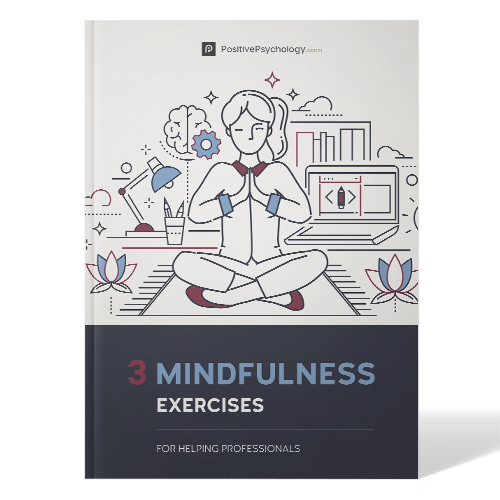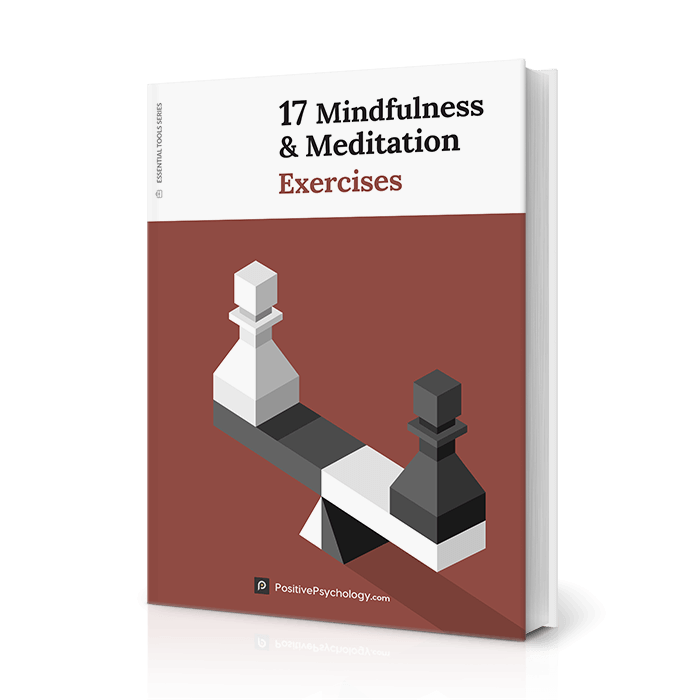The Mindful Attention Awareness Scale (MAAS)
 Ever found yourself driving and suddenly unaware of how you got to your present location?
Ever found yourself driving and suddenly unaware of how you got to your present location?
Do you find yourself walking fast to get somewhere and missing the experience of getting there?
How about plowing through your meal without tasting it?
We are all susceptible to the “busyness” of life and the detachment from the valuable and satisfying experience of our daily lives. Our brains tend to go on autopilot to conserve energy. By saving energy, our minds are robbing us of the delicious moment-to-moment experience that improves psychological and physical wellbeing.
While humans vary in their abilities in trait mindfulness, those who have effectively cultivated it live lives with higher levels of autonomy, pleasant affect, vitality, and satisfaction.
The most popular scale to measure mindfulness is the Mindful Attention Awareness Scale. It has been validated across cultures and age groups. It has been helpful in various areas of research, especially in self-determination theory and consciousness. It can be useful in helping people discover a baseline to cultivate this inherent human ability.
Let’s explore how the MAAS can give you an indication of a baseline in mindfulness, and how this scoring can help improve your moment-to-moment experiences.
Before you read on, we thought you might like to download our three Mindfulness Exercises for free. These science-based, comprehensive exercises will not only help you cultivate a sense of inner peace throughout your daily life but will also give you the tools to enhance the mindfulness of your clients, students, or employees.
This Article Contains:
What is the Mindful Attention Awareness Scale?
The research that created the MAAS investigated mindfulness as an attribute that varies between and within people (Brown, Ryan, 2003). Humans vary in attention and awareness to present events and experiences. The inherent capability differs in individuals due to levels of discipline, self-regulation, and personality.
The MAAS assesses individual differences in the frequency of mindful states over time. The scale is a 15-item (1-6 Likert scale) questionnaire to assess dispositional (or trait) mindfulness. The measurements from the MAAS tap consciousness related to self-regulation and various areas of wellbeing.
As a trait, it is shown that some individuals are more proficient at putting themselves into a state of mindfulness than others. It is also suggested that the willingness and practice of mindfulness varied as well. Focusing our internal radar is a skill that can be improved.
This scale is based around the understanding that all humans have a “radar” for internal and external experience, which is awareness. Consciousness is built through harnessing the focusing of that awareness, which is attention. Mindfulness is enhanced attention to and awareness of current experience or the present moment.
This scale intentionally excludes mood, attitude, and motivation to keep dispositional mindfulness neutral as a construct. The MAAS measures one’s tendency toward mindfulness or mindlessness. Scores of the MAAS strongly correlate with self-consciousness, rumination, and self-reflection.
Those scoring higher in mindfulness tend to report higher levels of pleasant affect, higher self-esteem, optimism, and self-actualization. Also, lower levels of neuroticism, anxiety, depression, and unpleasant affect are reported in those scoring higher in mindfulness.
Some of the basic needs of humans like autonomy, relatedness, and competence are typically met in someone who has a higher tendency to pursue the practice of mindfulness actively.
A Brief Look at the Authors Brown and Ryan
Research in mindfulness has taken vast leaps since the introduction of the MAAS in 2003.
The authors of this scale are continuing their excellent research and initiatives to better understand mindfulness and its role in self-determination theory and human consciousness. Their valuable work continues to improve our understanding for improvements in wellbeing practices.
Kirk Warren Brown, Ph.D. is an associate professor at Virginia Commonwealth University. He continues to be interested in consciousness and its role in human functioning. The research in social psychology surrounding mindfulness and its effect on compassion and emotional self-regulation continues to intrigue him and his colleagues.
Community-wide interventions in mindfulness practices have been improving the world around this research. A recent article about kindness and strangers showed the role of mindfulness in outreach. The impact of this research is far-reaching.
Richard M Ryan, Ph.D. continues to research self-determination theory and its relationship to mindfulness. His research on human motivation is world-renowned. He is considered an expert in the field. He continues his work as a professor at the Institute for Positive Psychology and Education, Australian Catholic University, North Sydney.
Self-determination theory and its applications can be found in the following areas: education, healthcare, relationships, psychotherapy, psychopathology, organizations, sports & exercise, goals, health & wellbeing, and the environment. It is an exciting area of research. The development of interventions and programs to affect change is profound.
When asked about his research since 2003, Dr. Ryan was kind enough to reply:
“Our interest in mindfulness relates to our broader view within self-determination theory that awareness contributes both autonomous regulation (because with greater awareness people make better choices and act with more congruence) and wellness (because mindful awareness helps us both avoid bad experiences, and better appreciate and savor good ones). So since 2003, we have been expanding our research in the connections between both mindful awareness and interested self-reflection on peoples quality of experience and behavior.”
When asked how practitioners might utilize the MAAS in real-life settings such as coaching, Dr. Ryan replied with the following:
“The MAAS is pretty straightforward, so it might be of interest to people as a change score. We haven’t used it that way in research, but it might be a good “mirror” or at least point of discussion and interest.”
In 2015, Brown and Ryan edited The Handbook of Mindfulness: Theory, Research, and Practice. This book explores the evolving field of study of mindfulness and its application in improving life satisfaction. Interventions for behavioral and emotion dysregulation disorders like depression, anxiety, addictions, and physical health conditions are examined.
As their work continues to improve practitioners’ understanding of the role of mindfulness in wellbeing, further interventions can be developed. The more we know about consciousness, the more we can harness the benefits in wellbeing, and how a deeper understanding of awareness and attention improves humans.
How Does the Scoring Work?
To score the MAAS, a mean of the 15 items (collected in a Likert scale) is calculated. For those who may not be mathematically minded, the mean equals the sum of the answers divided by the total number of questions (15). Higher scores reflect higher levels of dispositional mindfulness. With these higher scores also come lower reported negative emotional states.
Average scores for undergraduate students in the research were 3,85. Zen meditators scored an average of 4,38. Statistically, those who actively participated in mindfulness activities reportedly had fewer and less intense instances of negative emotional experience. Also, a study done on people living with cancer showed that those awake to their mortality increase the moment-to-moment appreciation of their lives.
Paying attention & mindfulness – Sam Chase
A Look at the Validity and Reliability of the MAAS
Any self-report measurement allows for the difficulty in accuracy. Though the scale requests that the participant reflects on their experiences as they are, rather than how they think they should be, humans tend to answer inaccurately where subjective experience is concerned. It is exceedingly difficult to measure “present” state in a “post” state manner.
A deeper understanding of mindfulness and its role in self-determination theory has been helpful in many different areas, including but not limited to the adherence to medical recommendations.
Validation of the scale’s usefulness in a cancer patient study showed improved wellbeing in patients more attuned to their internal and external experience. Facing mortality allows for increased mindfulness practice and with-it adherence to suggested treatments.
The scale has been validated among college students, community adults, and cancer patients, and it has been translated into at least five different languages.
It has also been adapted to consider adolescent and child perspective, as there is burgeoning research in the field of childhood interventions in mindfulness practice (Brown, 2011). Benefits in teaching children and adolescents mindfulness activities are far-reaching and incredibly effective.
Having this scale validated in many different areas has led to further research and vital development of positive psychology interventions. Adhering to the basic scientific principle that a phenomenon can be studied only if it can be adequately defined and measured, gives a more significant validation to the field of mindfulness and consciousness as a significant area of further scientific study.
Where Can I Find the Questionnaire Online? (PDF)
Here is a link to the Mindful Attention Awareness Scale for adults, plus we have more mindfulness questionnaires and scales on our own blog for you to enjoy.
A Take-Home Message
The Mindful Awareness Attention Scale has advanced research in positive psychology, social psychology, and child psychology since 2003.
More exciting research is being done within self-determination theory and human motivation to provide further measurable science to develop continued interventions and improvement in human beings. The more we know about the construct, the more effective the practice of mindfulness can become.
More conscious humans in the world will create a better world. When people are more aware of their internal experience, their motivation, and their personal ability to show up exactly as they want will create ripples in the humans around them. We, as practitioners, have the science at our fingertips and can utilize the MAAS as a baseline to create change.
Thanks for reading!
We hope you enjoyed reading this article. Don’t forget to download our three Mindfulness Exercises for free.
- Brown, Ryan 2003 Journal of Personality and Social Psychology Copyright 2003 by the American Psychological Association, Inc. 2003, Vol. 84, No. 4, 822–8480022-3514/03/$12.00
- Brown, K. W., West, A. M., Loverich, T. M., & Biegel, G. M. (2011). Assessing adolescent mindfulness: Validation of an Adapted Mindful Attention Awareness Scale in adolescent normative and psychiatric populations. Psychological Assessment, 23(4), 1023–1033.
Let us know your thoughts
Read other articles by their category
- Body & Brain (49)
- Coaching & Application (57)
- Compassion (26)
- Counseling (51)
- Emotional Intelligence (24)
- Gratitude (18)
- Grief & Bereavement (21)
- Happiness & SWB (40)
- Meaning & Values (26)
- Meditation (20)
- Mindfulness (45)
- Motivation & Goals (45)
- Optimism & Mindset (34)
- Positive CBT (29)
- Positive Communication (20)
- Positive Education (47)
- Positive Emotions (32)
- Positive Leadership (18)
- Positive Parenting (4)
- Positive Psychology (33)
- Positive Workplace (37)
- Productivity (17)
- Relationships (46)
- Resilience & Coping (36)
- Self Awareness (21)
- Self Esteem (38)
- Strengths & Virtues (32)
- Stress & Burnout Prevention (34)
- Theory & Books (46)
- Therapy Exercises (37)
- Types of Therapy (64)





What our readers think
is there any reverse coded item in MAAS (Mindful Attention Awareness Scale). Or MAAS have any subscale?
Hi Muhammad,
The MAAS does not use reverse-coded items; all items directly measure the construct of mindfulness, where higher scores indicate greater mindfulness.
I hope this helps!
Warm regards,
Julia | Community Manager
Yes it is very helpful for me, thats all i need, Thank You , Always stay happy and blessed.
Good evening mam,
I’m Madhumitha C MSc Nursing I year student studying in Sri Ramachandra institute of higher education and research , Chennai, Tamil Nadu, India.I am conducting a research on Effectiveness of Mindful attention awareness breathing on attention and well being among undergraduate nursing students . kindly give me permission to use MAAS SCALE in my research .it is useful for my study.
Thank you mam
Good afternoon mam , I am Preeti , research scholar in the department of psychology from central university of haryana, mhendergerh, INDIA. I am conducting a research on variable mindfulness among adolescents. Please give me permission to use MAAS in my research. Also provide manual of MAAS.
Thanking you
Hi Preeti,
This scale is freely available to use and a copy of it with scoring information can be accessed here.
Hope this helps!
Warm regards,
Julia | Community Manager
Glad to find the MAAS as my scholarly project practice intervention is on Mindfulness as a means of balancing work, school and life successfully. How does MAAS assist in developing a comprehensive questionnaire for the project.
hello, i want to use MAAS 15 item scale for my dissertation, how can i get permission to use this scale? Or is this open to use?
Hi Rida,
This scale is freely available to use and a copy of it with scoring information can be accessed here.
Hope this helps!
Warm regards,
Julia | Community Manager
We want criteria to check the scores .
Hi Jashan,
To calculate the MAAS score, the average of the 15 items (gathered using a Likert scale) is determined. Simply put, the average is found by adding up the responses and dividing by the total number of questions, which is 15. A higher score indicates greater dispositional mindfulness, and those with higher scores often report fewer negative emotional states.
I hope this helps!
Warm regards,
Julia | Community Manager
good afternoon dear friends, happy to find this MAAS as part of my dissertation research related to mindfulness. I’m looking for indicators or dimensions related to the questionnaire. Can you help me find the indicators so that it becomes a comprehensive questionnaire. Thank You
Poniman
Hi!
I’m glad you’ve found the Mindful Attention Awareness Scale (MAAS) useful for your dissertation research on mindfulness. To create a comprehensive questionnaire, you can consider these indicators:
– Attention and Awareness.
– Mind-Wandering Frequency.
– Present Moment Awareness.
– Judgment and Acceptance.
– Emotional Regulation.
– Mindful Behavior.
– Impact on Daily Life.
– Self-Compassion.
– Awareness of Physical Sensations.
– Mindfulness Practices.
I hope this helps 🙂
Warm regards,
Julia | Community Manager